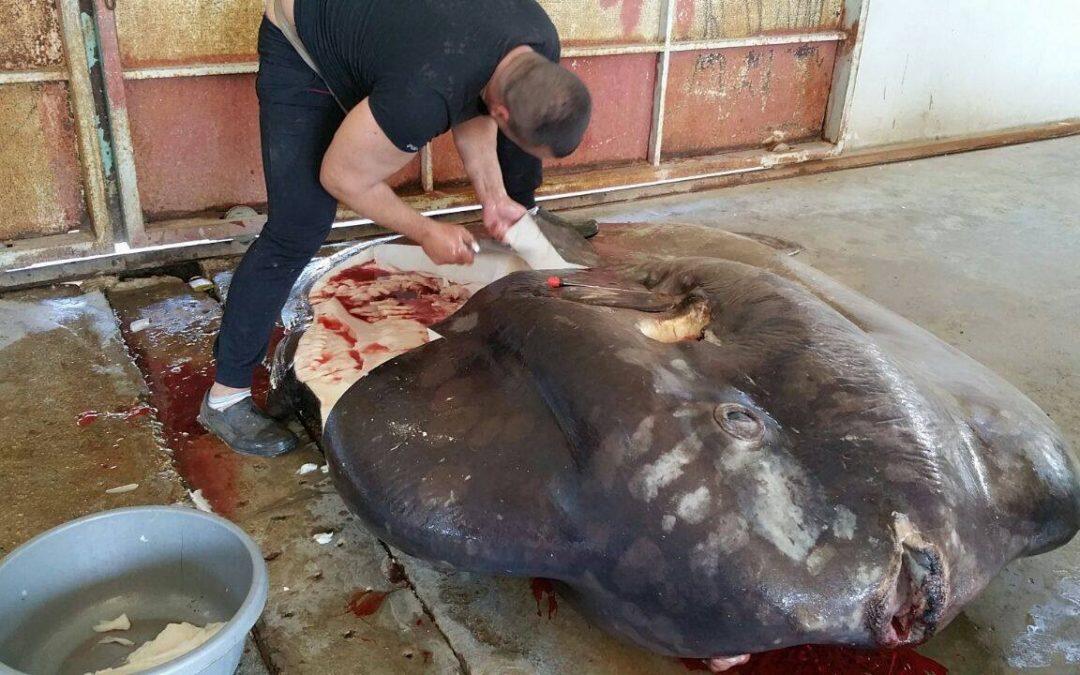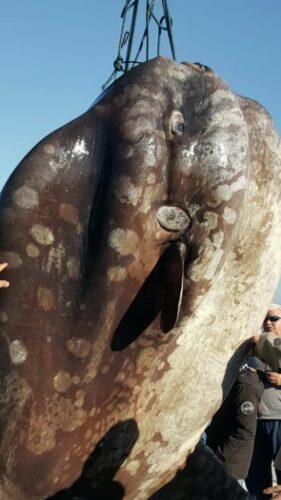On Sunday morning, February 5th, a fisherman in the port of Tripoli was able to catch a huge fish in a “high sheet net” (a special type of fishing net), the fish weighed less than a ton, this raised the curiosity of people who had gathered to see this “strange marine creature”, and as usual when some exotic fish is caught, many interpretations and conclusions about its name and whether it is an invasive species, or if it’s edible? Although this huge exotic fish was known to fishermen in Tripoli area where it has been caught several times since five years in the Qalamoun district.
It’s obvious that anglers and citizens found the presence of these types of fish in our sea so strange, and felt utter fear by it, and that it’s not just unusual to them but also rare, and because of the ignorance of most people, sailors and fishermen of some of these species that live in or migrate to our sea, and that they don’t have the slightest idea about; this requires spreading awareness about this fish and similar alien species, especially in the fishermen’s society, as well as in some cases where they’re hunting endangered species, or when the law prevents catching certain species as they’re on the red list of threatened species and are protected by international agreements.
Akar: this is not the first case
Consequently, greenarea.info took the initiative to investigate the presence of this exotic fish, especially since its shape is unfamiliar, as well as its massive size which pose many question marks about what we’ve witnessed lately on the Lebanese shores of changes in the biodiversity, resulting in endangering dozens of species in our marine ecosystems.
The Chairman of the “cooperative Fish port – Tripoli” Ahmed Akar told greenarea.info that it “is not the first time that this type of fish is caught in Tripoli,” and he emphasized that “It’s caught in the a special kind of high nets of one of the fishermen in the harbor,” pointing out that “the weight is massive nearly a ton or more, so that the hunter needed to hire a crane to lift and transfer it from the water”.
What was serious that the fish was cut and sold in pieces and kilograms, and as confirmed according to experts in marine biology, this fish may in some cases cause poisoning, and this may expose people’s health to risk.
Professor Bariche: its principal food is Jellyfish
In order to know more about this fish and determine the species scientifically, greenarea.info contacted the specialist in Marine Biology and Marine Sciences Professor Michel Bariche so as to cut off all the debate concerning this species, he confirmed that it is the Ocean Sunfish Mola mola, Bariche added: “It is one of the heaviest fish by weight, with weighing up to a thousand kilograms, and this kind of fish live in most seas, and is found in warm and temperate waters in all oceans”, and he pointed out that: “this fish floats often as a leaf on the surface of the water and appears as missing its posterior end because it lacks the caudal fin, which means that almost as the caudal fin is amputated while its two pectoral fins are rounded”.
Bariche also pointed out that “the skin is very thick and rough, and its body flat horizontally, and features a small mouth, this fish lives on a diet consisting mainly of jellyfish, it’s also in danger if it swallows plastic bags (mistaking them for jellyfish)”.
Meat unpalatable and may be toxic
The Ocean Sunfish is usually present at different depths between the surface and a depth of 400 meters, and rarely appear as a group in some areas, and is one of the most fertile vertebrates, according to the Guinness Book of world records, it lays about 300 million eggs, as this fish swims in a manner different than the rest of the fish as if it drags itself, since it floats in this way, it’s exposed to the adhesion of parasites, these parasites annoy it so it goes to where fish are located for the disposal of them, or go to the water’s surface, where the gulls do this job.
Bariche said: The Ocean Sunfish flesh is unpalatable and may be poisonous, but considered a delicacy in some regions, the largest markets being Korea, Taiwan and Japan after removing the toxins from it, they are not edible nor have importance in the fishing industry, but are caught accidently in padded and drift gillnet (special kind of nets), and it’s worth mentioning that despite their size, Ocean Sunfish are docile, and pose no threat to human divers”.
This fish is classified on the red list of “the International Union for Conservation of Nature,” the IUCN Red List, as vulnerable threatened of extinction, while the European Union prevented catching or selling it.
Bariche concluded: “We used to see it in our sea long time ago, and almost every year it’s caught in nets of one of the fishermen.”
Translated by: Suzanne Abou Said Daou















